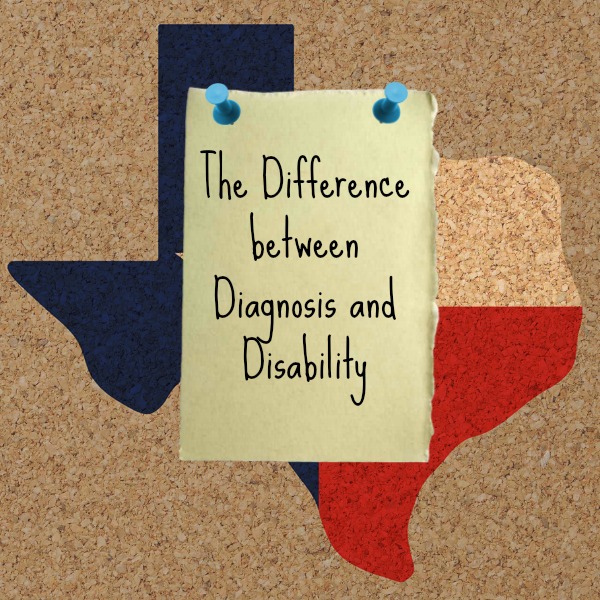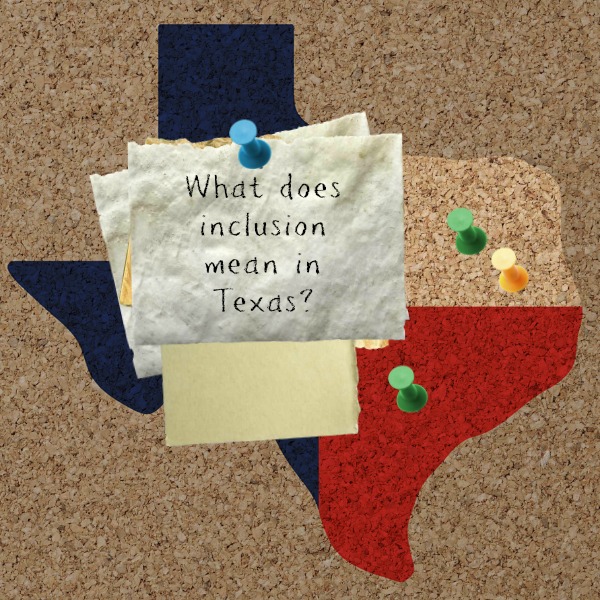What is Inclusion?
“Schools that describe themselves as having “full inclusion” are often referring to where students sit rather than to the beliefs of the educators providing services.” Somewhere along the line, in Texas, inclusion has also come to be understood as a service-delivery model rather a “belief system that values diversity and fosters a shared responsibility to help all students to reach their potential.” This lack of common understanding and common language has created a “mine” and “yours” ideology that has driven a stake between regular education teachers and special education teachers instead of uniting them in the common goal of providing all students with “free and appropriate education in the least restrictive environment” possible. Some of the confusion appears to be rooted in the the myths of inclusion and the lack of understanding of service-delivery models.
Inclusion is rooted in PL 94-142, also known as Individuals with Disabilities Education Act of 1975, or IDEA. In 2002, when No Child Left Behind was signed into law, school accountability for closing the achievement gap for students with disabilities came into the spotlight. Discussions about the meaning of Least Restrictive Environment (LRE), language used in the IDEA, were reignited. The IDEA 2004 LRE Mandate states the IDEA requires that “to the maximum extent appropriate, children with disabilities, including children in public or private institutions or other care facilities, are educated with children who are not disabled, and special classes, separate schooling, or other removal of children with disabilities from the regular educational environment occurs only when the nature or severity of the disability of a child is such that education in the regular classes with the use of supplementary aids and services cannot be achieved satisfactorily.” 20 U.S.C. ‘1412(a)(5)(A).”
Texas considers these factors when deciding what level of inclusion to provide for a student with disabilities:
- Has the district taken steps to accommodate the child with disabilities in regular education?
- Were these efforts sufficient or token?
- Will the child receive an educational benefit from regular education?
- What will be the child’s overall educational experience in the mainstreamed environment, balancing the benefits of regular and special education?
- What effect does the disabled child’s presence have on the regular classroom environment?
Inclusion is not co-teaching, and the two are not mutually exclusive. The are directly related, but they are not the same thing. If inclusion is the belief system that we embrace as a means for providing all students with the opportunity to achieve at the highest level possible, co-teaching is the model for delivery of service. And a highly effective model, at that. It is becoming apparent that this fundamental semantic breakdown is hindering the progress of effective service-delivery models in public education here in Texas.
References:
Special Education in Texas: The Difference between Diagnosis and Disability
 This is a confusing point of Special Education for many teachers and parents. Students may be diagnosed by a doctor outside of school as having a certain diagnosis, however students may only qualify for Special Education services if they fall under one of the disability categories set forth by the Individuals with Disabilities Education Act, or IDEA. Moreover, each state has the ability to define those categories as they see fit, as long as they retain the key elements of IDEA.
This is a confusing point of Special Education for many teachers and parents. Students may be diagnosed by a doctor outside of school as having a certain diagnosis, however students may only qualify for Special Education services if they fall under one of the disability categories set forth by the Individuals with Disabilities Education Act, or IDEA. Moreover, each state has the ability to define those categories as they see fit, as long as they retain the key elements of IDEA.
The federal law (IDEA) uses the following terms to define a “child with a disability”:
- Autism,
- Deaf-blindness,
- Deafness,
- Emotional disturbance,
- A hearing impairment,
- Intellectual Disability,
- An orthopedic impairment,
- Other health impairment,
- A specific learning disability,
- A speech or language impairment,
- Traumatic brain injury,
- A visual impairment including blindness, or
- Multiple disabilities.
Texas uses the following list of disability categories to determine if a student (aged 3-21) is eligible for special education and related services:
- Auditory Impairment (AI)
- Autism (AU)
- Deaf-Blindness (DB)
- Emotional Disturbance (ED)
- Intellectual Disability (ID) (formerly called Mental Retardation)
- Multiple Disabilities (MD)
- Orthopedic Impairment (OI)
- Other Health Impairment (OHI)
- Learning Disability (LD)
- Speech Impairment (SI)
- Traumatic Brain Injury (TBI)
- Visual Impairment (VI)
- Non-Categorical Early Childhood (NCEC)
Disability is determined through evaluation by a licensed school psychologist, and accepted by a committee that includes the student’s parent or legal guardian during the initial Admission, Review and Dismissal committee meeting. If a child doesn’t qualify for Special Education services, they may still be eligible for services to be provided under Section 504 of the Rehabilitation Act of 1973 to ensure that their individual educational needs are met as adequately as those of non-disabled students.
New Teacher To-Do List for Special Education Teachers
If you are a special education teacher, the beginning of your year looks a little differently than it does for the content area teachers. Unless you are teaching an intervention class, you probably don’t have a room to prepare and you aren’t busy thinking about lesson plans. It can feel like there really isn’t anything to do except get your office organized and wait to meet your students. At least that is how I felt my first year. I didn’t know where to start.
While there is an element of waiting involved because you need to assess the students on your caseload before you can really begin any intervention, there are some things you can be working on during those teacher workdays to get yourself ahead of the game.
1. Get your caseload. First things first: you need to know who your students are before you can really start doing much of anything. Your Special Education coordinator should have this information, more or less, by the start of the school year. There are always little last minute changes, but you should have a solid list by the time you show up for teacher workdays.
2. Make student files/folders. I like to have one manila folder to keep each student’s important data. Don’t make it complicated, or you won’t use it.
3. Figure out your student’s class schedules. This is also a good thing to staple onto the front your student folder, and stick a copy in your teacher binder. This comes in handy when you are trying to locate students for progress monitoring.
4. Create your teacher information binder.
5. Write a letter to parents, introducing yourself as their child’s case manager. It’s good to make that first connection early. Starting out on the right foot with parents will set your year up for success. Open communication between parents and teachers is essential when it comes to helping your students meet their IEP goals for the year.
6. Familiarize yourself with your student’s IEP and MDT information. This is a great way to get to know your students before you meet them. You can learn their strengths, what they worked on last year, and most importantly their goals for the upcoming year. It is also a good idea to note if you have any yearly review meetings right of the bat, so you can get everything in order. **More on that in a future post!**
7. Locate the assessment materials you will need for progress monitoring. Sometimes these can be hidden away in a book closet, or have been unintentionally hoarded by another teacher (gasp!). Ask around. Find out what your school and your district approves for math, reading, and writing probes. You will probably receive some information about this at new teacher orientation. You will want these materials ready to go in the first couple weeks so that you can assess where your students are at, and use the assessments to begin working on strategies with them.
7. Introduce yourself to your co-teachers, and schedule a time to plan together. Take the initiative and get this relationship off to the best start. A great co-teaching relationship can be a wonderful experience, but an poor one can make your year seem 18 months long. Show your co-teacher that you are ready and willing to jump in and be by his/her side, not standing in the back of the room.
Hopefully, this will help new Special Education teachers figure out where to start on those first few days. Don’t worry, once the year gets going, you won’t have any trouble finding things to do!!
I’m live on Teachers Pay Teachers!
I love Teachers Pay Teachers. As I was working on my beginning of the year things, I started playing around with making them more…attractive. Then, I decided that if I was going to go to that much work to make my stuff look nice, I might as well share. I don’t expect to join the 20K club anytime soon, but I would be happy if you found the stuff I made useful and shared with your teacher friends! Go check out my Special Education Teacher Binder on TpT and let me know what you think. Thanks!













